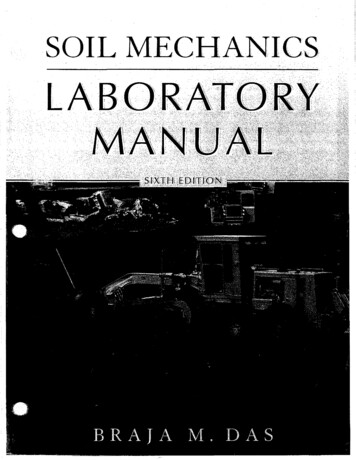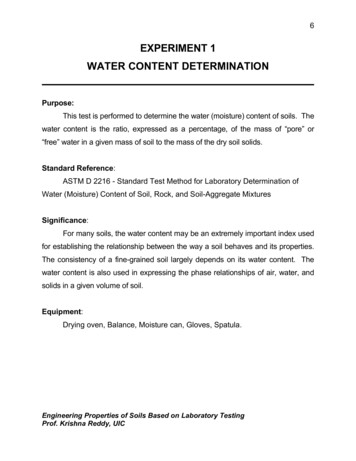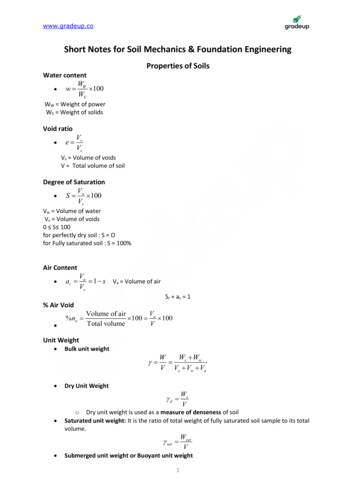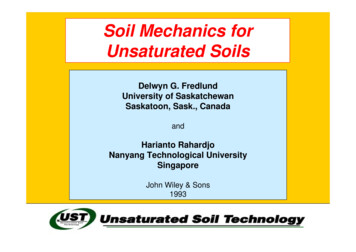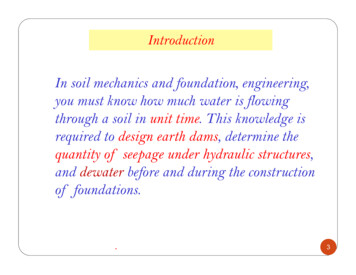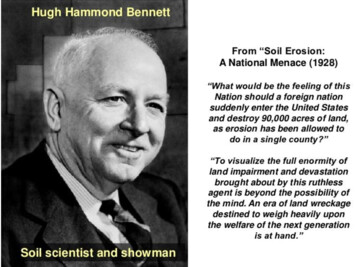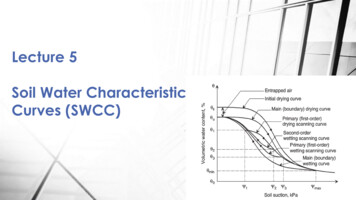
Transcription
Lecture 5Soil Water CharacteristicCurves (SWCC)
Surface Tension, Review
Physical Model for Capillary The capillary model provides a mathematicalrelationship between the radius of curvatureof the air-water meniscus and the pressuredifference between the air and water phases. The difference between the air pressure ua andthe water pressure uw was shown to bebalanced by the surface tension Ts acting atthe wetting angle α along the solid surface.
Matric Suction and Soil Strength Surface tension has the ability to support a column of waterin a capillary tube. The surface tension associated with the contractile skin places areaction force on the wall of the capillary tube. The vertical component of this reaction force producescompressive stresses on the wall of the tube. In other words, theweight of the water column is transferred to the tube through thecontractile skin. The contractile skin results in an increased compression on the soilstructure in the capillary zone. Therefore the presence of matric suction in an unsaturated soilproduces a volume decrease and an increase in the shear strengthof the soil.
Soil-Water Potential Definition: The amount of work that must be done per unit of a specifiedquantity of pure water in order to transport reversibly and isothermally aninfinitesimal quantity of water from a specified source to a specified destination. Total Soil-water potential can be categorized into four subgroups as: Matric Potential ( m ) Osmotic Potential ( o ) This component is related to the salt content in the water. π νCRTKPressure Potential ( p ) As we discussed in previous lecture, this component is related to the difference between poreair and pore water pressure in soils. m Ua-UwRecall from your CE4348, the pressure potential can be calculated as : p wghGravitational Potential ( g ) Is related to the weight of the materials and can be calculated as: g MgZ
Total, Matric, and Osmotic Suctions forGlacial Till (Krahn and Fredlund, 1972)
Components of Soil Suction and Total Suctionfor Regina Clay (From Fredlund,2002).
Designation of the Amount of Water in SoilsThe amount of water in the soil can be defined using more than onevariable. Variables used to define the amount of water in the soil are:i.Gravimetric water content w,Mww Msii.Volumetric water content θ, VwVv Vsiii.Degree of saturation S,S VwVviv.Volume of water, Vw , referenced to the original volume of the specimen, V0(i.e., Vw/V0).
Gravimetric vs. Volumetric Water ContentExampleDuring field trial, the field engineer collected a 200 cm3 soil sample. Its moistweight was measured as 150 g. After drying, the dry weight was 100 g.Determine the volumetric and gravimetric water contents of this soil. Gravimetric Water Content:w Moist Weight Dry Weight 150 100 50%Dry Weight100 Volumetric Water Content: Volume of Water 150 100 25%Total Volume200
Advantages and Disadvantages of VariousDesignations for Amount of Water in Soil
The Soil Water Characteristic Curve (SWCC) The Soil Water Characteristic Curve (SWCC) describes the functionalrelationships between soil water content ( , w, or Sr) and matric potentialunder equilibrium conditions. The SWCC is an important soil property related to pore space distribution(sizes, inter-connectedness), which is strongly affected by texture, voidstructure and other factors such as organic content. The SWCC is a primary hydraulic propertyrequired for modeling water flow inporous materials. The soil-water function is highly nonlinearand relatively difficult to obtain accurately.
The Soil Water Characteristic CurveEarly conceptual models for SWC curve were based on the"bundle of cylindrical capillaries" (BCC) representation ofpore space geometry (Millington and Quirk, 1961).The BCC representation postulates that at a given matricpotential a portion of interconnected cylindrical pores arecompletely filled with liquid, whereas larger pores arecompletely empty.Soil sampleactualporeequivalentcapillary
The Soil Water Characteristic Curve- Bundle ofCylindrical Capillaries (BCC) AnalogyThis convenient idealizationof soil pore space, enables alinkage between the soil poresize distribution and theSWCC based on capillary riseequation:2 T cos hi w g ri
Soil Water Characteristic Curves Also Represent WaterContent as a Function of Height Above Water Table15
Effect of Particle Size on the Height ofthe Capillary Rise
Relationship Between Matric Suction andPore Size for Various Soils
Relationship Between Void Ratio andSoil Suction
Relationship between Water Contentand Soil SuctionThere is a strong linkagebetween the SWCC and theunsaturated soil propertiesand this relationship mustbe maintained throughoutthe numerical modelingprocess.
Typical SWCC for Soils of Different Texture
Matric Suction and Fines Content
Drying Phenomenon Showing RelationshipBetween Air-Entry Value (AEV) and ShrinkageLimit of a Soil (After Marinho, 1994). Drying of a saturated soil (e.g., starting at pointA) follows the saturation line until air begins toenter the largest soil voids at point B. Point B is an indication of the air-entry value(AEV) of an initially slurry soil. As the soil continues to dry, it reaches a minimumvoid ratio beyond which there is no furthervolume change. When the water content of thesoil reaches zero, the soil suction has increased to1,000,000 kPa (i.e., point D) which is the upperlimit of the soil suction.
Shrinkage Curve
Air Entry Value (AEV) and Residualwater Content ( r) The air-entry value of the soilis the matric suction where airstarts to displace water in thelargest pores in the soil. The residual water content is thewater content where a largersuction change is required toremove additional water fromthe soil. In other words, there is achange in the rate at which watercan be extracted from the soil.
Identification of the Zones on the SWCC
(a)Hysteresis and Scanning Curvesr(b)RGashd Tension of the soil for a given water content is not unique, but depends on thehWsoils history of wetting and drying, therefore the SWCC is not a unique curve. During wetting the small pores fill first and duringdraining the large pores empty first. The intermediate loops in the plot are called thescanning curves, indicating the transitionsbetween the wetting and drying branches. Meniscus radii is greater in an advancing fluidthan in a retreating one. Entrapped air in a newly wetted soil decreaseswater content per unit suction. Clay-rich soils change geometry through swellingand shrinking during wetting and drying.1LiqSoliuid2d
Ink Bottle Analogy duringSorption and DesorptionVisualization of the ink bottle analogy for equilibrium height of waterin a variable width pore:Capillary Drainage(Desorption or Drying)(a)rDuring wetting the smallpores fill first and duringdraining the large poresempty first.Capillary Rise(Sorption or WSolidLiquid12uidLlid iquidSolidSoGas22
Influence of Height, Radius, andShape Effects on Capillary Action
Hysteresis of SWCC, Cont. The drying and wetting SWCCs are significantlydifferent, and in many cases it becomesnecessary to differentiate the soil propertiesassociated with the drying curve from thoseassociated with the wetting curve. This means that the geotechnical engineer mustmake a decision regarding the process that is tobe simulated. It might also be appropriate in some cases to usean average SWCC (i.e., between the drying andwetting SWCCs) when estimating unsaturatedsoil property functions.
SWCC ModelsFredlund and Xing (1994)
Best-fit Curves Fitted To Experimental Data UsingThree Representations Of Water Content
SWCC Fredlund-Xing Equation (1994)Fredlund and Xing proposed the following relationship between volumetric watercontent and soil suction:af , nf , mf Three fitting parameters,θ Volumetric water contentθs Saturated volumetric water content, ande Irrational constant equal to 2.71828. Soil suction
Sensitivity Analysis of Shape Parameters ofthe Fredlund-Xing EquationEffect of af soilparameter onSWCC when nf 2and mf 1
Sensitivity Analysis of Shape Parameters ofthe Fredlund-Xing EquationEffect of mf soilparameter onSWCC when nf 2and af 100
Variation of Soil Suction with ParticleSize and water Content
Sensitivity Analysis of Shape Parameters ofthe Fredlund-Xing EquationEffect of nf soilparameter onSWCC when mf 1and af 100
Estimation of the Model ParametersZapata-1999 Zapata (1999) used a database of approximately 190 soils collected from previouslypublished data. The soils collected were divided into two categories: plastic and non-plastic soils. The database consisted of approximately 70 plastic soils and 120 non-plastic soils. The data collected for the plastic soils consisted of the percentage of passing the No.200 sieve and the Atterberg limits, in particular, the plasticity index. The grain-size diameter D60 was used to represent non-plastic soils. Each soil used in the statistical correlation had a measured and well-defined SWCC. The weighted value of PI, which is the percentage passing the No. 200 sieve (used asa decimal value) multiplied by the plasticity index (i.e., wpPI) was used tocharacterize the plastic soils. The correlation study yielded a family of SWCCs for both plastic and non-plasticsoils. The results of the Zapata’s study have been used as part of the EnhancedIntegrated Climatic Model (EICM) in the new Mechanistic Empirical PavementDesign Guide (MEPDG).
Family of SWCCs for Non-Plastic SoilsBased on Zapata’s Model (1999)
Family of SWCCs for Plastic Soils Basedon Zapata’s Model (1999)
Combined Family of SWCCs for Plastic andNon-plastic Soils (after Zapata, 1999).
Estimation of the Model Parameters forGranular Soils- Torres, 2011Torres (2011) analyzed a database of about 4500 granular soils and found that the D10particle size produced improved correlation coefficients to those obtained when usingthe D60 particle size. The correlation coefficients were obtained for the Fredlund andXing (1994) SWCC equation.The soil suction at residual conditions, ψr , wasfound to be relatively constant for all granularsoils: r 100 kPa
Application of SWCC The SWCC constitutes the primary soil information required for the analysis of seepage,shear strength, volume change, air flow, and heat flow problems involving unsaturatedsoils (Fredlund, 2000). The permeability function and the water storage function for an unsaturated soil arerelated to the SWCC. The coefficient of permeability is known to become extremely low and hydraulic flowwould appear to essentially cease near residual conditions, giving way to vapor flow. Inother words, there appears to be a change from liquid flow to vapor flow as residualsuction is exceeded. The effective angle of internal friction can be applied to a soil up to the air-entryvalue. The friction angle then decreases until it becomes essentially zero at soil suctionsexceeding residual soil suction. Recent research on a number of soil types indicate thatthe angle of friction tends toward zero at high soil suctions (Fredlund, 2000).
Devices for Measuring Soil Suction
Range of Suction Values Measured with Various Tests
Relationship between Volume-MassProperties of Soils
The Soil Water Characteristic Curve (SWCC) describes the functional relationships between soil water content ( , w, or Sr) and matric potential under equilibrium conditions. The SWCC is an important soil property related to pore space distribution (sizes, inter-co


